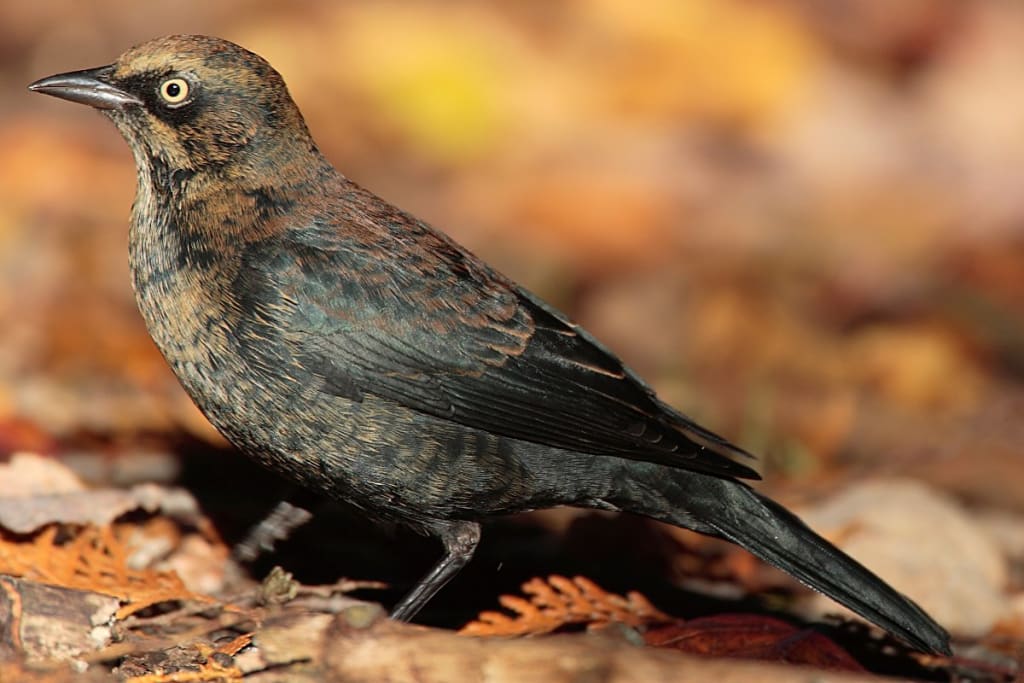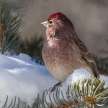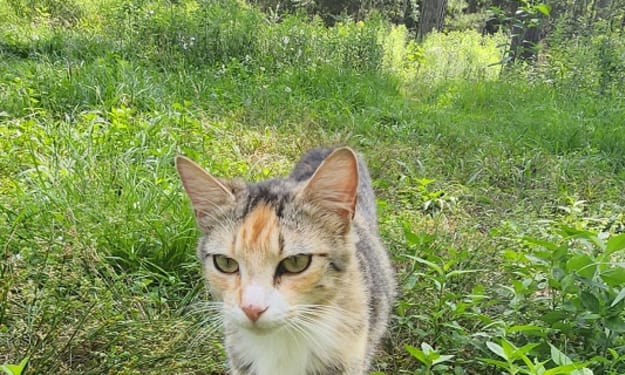
The rusty blackbird (Euphagus carolinus) is a medium size blackbird, closely associated with grackles ("rusty grackle" is the species ' older name). It is a genus that prefers wet land environments, occurs in the boreal forest and muskeg throughout Northern Canada, and migrates southeast to the United States during the winter. Formerly abundant, the rusty blackbird has undergone one of the largest declines of any native bird species in North America in the last couple of years for reasons not well understood. Adults have bright, white eyes and a pointed head. They have black plumage with slight green and purple gloss; the female is greyer. "Rusty" means winter brownish plumage. They resemble the blackbird of the Brewer, the western member of the same genus; however, the Brewer's have a longer tail, and the head of the male is iridescent green.
Its breeding range is moist temperate coniferous forests and muskeg throughout Canada and Alaska. Usually, birds nest at the edge of ponds and streams, often over snow, with a cup nest in a tree, or dense shrub. Dragonflies that emerge in the summertime and their larvae are essential food products. These birds migrate to the east and southeast of the United States through areas of the Grain Belt, sometimes straying via Mexico. In wet soil or shallow water they forage, feeding mostly insects, small fish and some seeds.
Their most common way of foraging is deliberately tossing and breaking leaves at submerged aquatic plants. Mast-growing oaks, such as willow oak, are also important. In certain regions nuts of planted pecans are used extensively. They are rarely targeting only small passerine birds, and are known to kill species as big as the common snipe. They feed in flocks during migration and on the wintering grounds, often joining other blackbirds, sometimes occurring in single-species flocks. They roost most often with other blackbirds; some small roosts in old fields are in brushy scrub, and others in large mixed flocks, mostly in urban areas.
The species nests relatively early for a boreal forest bird. To finish off their moult they remain in the boreal zone. Autumn migration is slow, with birds in the northern states sometimes staying well into December; spring migration is much more swift. The largest wintering concentrations are in the lower Mississippi Valley, with lesser concentrations in the Piedmont and South Atlantic coastal plains. For much of the year, both males and females will sing in late winter and spring, in fairly quiet autumn migration. The song consists of gurgling, and high-pitched squeaks. Rusty blackbirds have declined significantly over the last few decades. The reasons remain unclear but probably the loss of biodiversity is a major contributor to the decline. Habitat destruction is possibly due to several reasons including production of oil, coal and mining, hydroelectric dams and clearance of forests. Contamination of mercury can be a problem for North American populations in the Northeast.
Rarer than previously believed, from a Least Concern species to Endangered status it has been listed on the 2007 IUCN Red List. Deliberate poisoning in the southeastern United States with mixed-species blackbird flocks, including brown-headed cowbirds, common grackles and red-winged blackbirds. Wwe may also play a role; the number of rusty blackbirds killed by these poisonings is not known at this time. Acid rain can reduce the abundance of calcium-rich invertebrates on which the rusty blackbird relies in the eastern portion of its range for food. By contrast, citizen science projects such as the North American Breeding Bird Survey and Christmas Bird Count have shown that rusty blackbirds have dropped 85%-98% in the last 40 years. This is deeply worrying for some people, because researchers are desperately working to figure out what really went wrong. Sighting subscription services such as eBird invite birders to watch rusty blackbirds. The International Rusty Blackbird Working Group handles and carries out studies on this species on a daily basis since 2005.
About the Creator
MB
I am a bird aficionado and really enjoy spotting them them on hikes. I greatly appreciate the variety of birds cross North America and the world. They are amazing and intelligent creatures, each so unique and with a wonderful life.






Comments
There are no comments for this story
Be the first to respond and start the conversation.